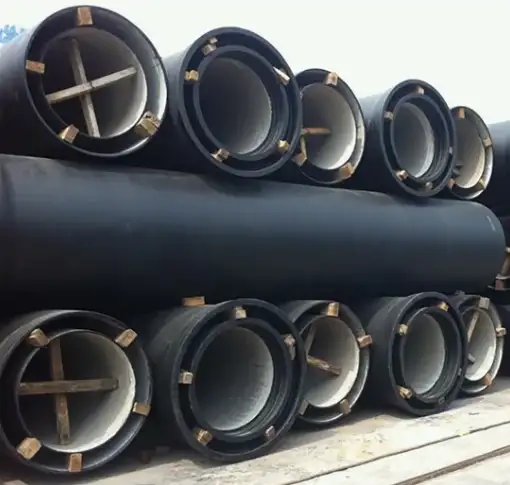Repairing a hole in ductile iron pipe requires assessing the damage size and selecting an appropriate method—such as epoxy putty for small pinholes, full-circle clamps for moderate damage, or welded/sleeve repairs for large breaches.

1. Introduction
Ductile iron pipes are widely used in water and wastewater systems due to their strength and durability. However, like all materials, they can suffer from damage over time. Repairing holes in these pipes promptly is crucial to maintain system integrity and prevent further complications.
2. Understanding Ductile Iron Pipes
Ductile iron pipes are made from a special type of cast iron that has been treated to enhance its strength and flexibility. This makes them resistant to cracking and suitable for high-pressure applications. They are commonly used in municipal water systems, sewage systems, and industrial applications.
3. Identifying Types of Damage
Before initiating repairs, it’s essential to assess the type and extent of the damage. Common issues include:
-
Pinhole Leaks: Small, localized leaks often caused by corrosion.
-
Cracks: Fractures that may extend partially or completely through the pipe wall.
-
Large Holes: Significant breaches that may result from external impacts or severe internal pressure.
4. Preparation Before Repair
Proper preparation ensures the effectiveness of the repair:
-
Shut Off Water Supply: Ensure the affected section is not under pressure.
-
Drain the Pipe: Remove any water from the damaged section.
-
Clean the Area: Use wire brushes or sandpaper to remove rust, debris, and contaminants.
-
Dry the Surface: Ensure the area is completely dry before applying any repair materials.
5. Repair Methods
5.1. Temporary Repairs
Temporary repairs are suitable for immediate action until a permanent solution can be implemented:
-
Epoxy Putty: Mix and apply over the hole, allowing it to cure as per manufacturer instructions.
-
Rubber Patches: Use a rubber sheet and secure it with clamps to cover the hole.
-
Silicone Sealants: Apply around the damaged area to prevent leaks.
5.2. Permanent Repairs
Permanent repairs restore the pipe’s integrity:
-
Mechanical Clamps: Install a clamp over the damaged area to seal the hole.
-
Sleeve Liners: Insert a liner inside the pipe to reinforce and seal the damaged section.
-
Welding: For minor cracks, welding can be used to fuse the material back together.
6. Safety Protocols
Always adhere to safety guidelines during repairs:
-
Personal Protective Equipment (PPE): Wear gloves, safety goggles, and protective clothing.
-
Ventilation: Ensure adequate ventilation when working with chemicals or in confined spaces.
-
Training: Only qualified personnel should perform repairs, especially for high-pressure systems.
7. Maintenance and Prevention
Regular maintenance can prevent future issues:
-
Routine Inspections: Conduct periodic checks for signs of wear or damage.
-
Corrosion Protection: Apply protective coatings to prevent rust and corrosion.
-
Proper Handling: Ensure pipes are handled correctly during installation and maintenance to avoid physical damage.
8. Conclusion
Repairing holes in ductile iron pipes is essential to maintain the functionality and safety of water and wastewater systems. By understanding the types of damage, preparing adequately, and choosing the appropriate repair method, you can ensure a long-lasting solution.
9. Frequently Asked Questions (FAQs)
Q1: How do I identify a hole in a ductile iron pipe?
Identifying a hole involves:
-
Visual Inspection: Look for signs of water leakage or corrosion.
-
Pressure Tests: Conduct pressure tests to detect leaks.
-
Listening Devices: Use acoustic devices to detect sounds of escaping water.
Q2: Can I repair a ductile iron pipe myself?
While minor repairs can be done by experienced individuals, it’s recommended to consult professionals for significant damage to ensure safety and compliance with regulations.
Q3: How long do repairs to ductile iron pipes last?
The longevity of repairs depends on the method used and the conditions of the pipe. Properly executed permanent repairs can last several years.
Q4: What materials are best for repairing ductile iron pipes?
Materials include:
-
Epoxy Putty: For sealing small holes.
-
Rubber Patches: For temporary fixes.
-
Mechanical Clamps: For permanent solutions.
Q5: Are there any risks associated with repairing ductile iron pipes?
Risks include:
-
Improper Sealing: Leading to continued leaks.
-
Structural Integrity Loss: If repairs are not done correctly.
-
Exposure to Hazardous Materials: During the repair process.
Q6: How can I prevent holes from forming in ductile iron pipes?
Preventive measures:
-
Regular Maintenance: Conduct routine inspections and maintenance.
-
Protective Coatings: Apply coatings to prevent corrosion.
-
Proper Installation: Ensure pipes are installed correctly to avoid stress and damage.
For a visual demonstration of ductile iron pipe repair techniques, you can watch the following tutorial:
References:
AWWA C151/A21.51 – Ductile-Iron Pipe, Centrifugally Cast, for Water or Other Liquids
AWWA Resource: Hot Tapping of Mains – Guidance on Tapping Pressurized Water Pipelines
DIPRA – Service Connections and Tapping of Ductile Iron Pipe
Wikipedia – Ductile Iron Pipe Overview and Applications
OSHA – Personal Protective Equipment (PPE) Requirements for Pipe Work

